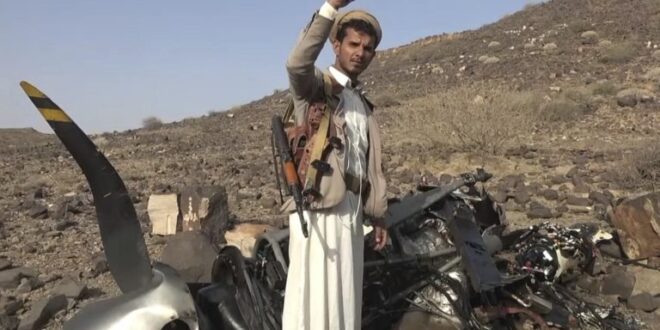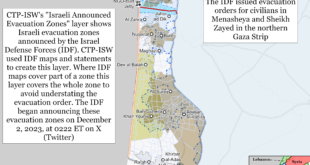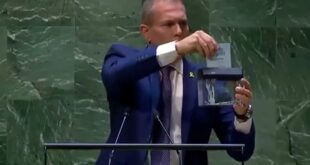Bottom Line Up Front
- Iran and its partners in the so-called “Axis of Resistance” have suffered some setbacks but continue their battle to undermine Israel’s war effort in Gaza.
- Israeli, U.S., and allied officials have not yet centered on a formula to establish lasting deterrence against any members of the Axis, including Iran itself.
- Iran-aligned militias in Iraq and Syria have resumed their attacks on U.S. forces after standing down for more than two months at Iran’s behest.
- The Houthi movement in Yemen continues to attack commercial shipping in the Red Sea, despite an April lull that suggested the group’s arsenal might be significantly diminished.
U.S. and global officials are assessing the effectiveness of their efforts to date to prevent the Hamas-Israel war in Gaza from expanding into a sustained conflict that encompasses the entire region. For the six months following the October 7 Hamas attack on Israel, the region appeared to settle into a predictable, if volatile, pattern in which Iran acted indirectly, through its so-called “Axis of Resistance” partners, to strike against Israel, Israel’s main backer, the United States, and global commerce transiting the Red Sea, as a means of exerting pressure on Israel to end its offensive against Hamas. Iran and its partners hope to enable Hamas, also a member of the Axis, to survive the war and retain power in the Gaza Strip. Lebanese Hezbollah engaged in exchanges of artillery and rocket fire across the Israel-Lebanon border to try to tie down Israel Defense Forces (IDF) troops and reduce pressure on Hamas in the Gaza Strip. Iran-backed militia groups in Iraq and Syria conducted 180 attacks on U.S. bases in those two countries to raise the price to the United States of its political and military support for Israel’s goal of defeating Hamas. Iran’s ally in Yemen, the Houthi movement, in November began a campaign of missile and armed drone attacks on commercial ships passing through the Red Sea to impose on the United States and its European partners significant economic costs for extending support to Israel.
Until April, Israeli, U.S., and allied forces seemed able to use limited but effective retaliatory strikes and the threat of further escalation to keep the various fronts from erupting into all-out warfare. Israeli strikes on Lebanese Hezbollah positions in south Lebanon have been weakening the group’s infrastructure across the Israeli border, and Hezbollah’s leadership was responsive to the pressure from Lebanon’s Sunni Muslim and Maronite Christian leaders that the group does not embroil Lebanon in another major war with the IDF. U.S. retaliatory strikes in early February against Iran-backed militias in Iraq and Syria – a response to the deaths of three U.S. military personnel at a base in Jordan on the Iraqi and Syria border – apparently convinced Iranian leaders that U.S. officials were shifting toward a harder-line policy that might result in U.S. strikes on Iranian territory. Iran’s Islamic Revolutionary Guard Corps – Qods Force (IRGC-QF) commander Esmail Qaani prevailed on the groups to announce a stand-down on further attacks on U.S. bases in the two countries. Throughout April, it appeared that the U.S. and allied campaign to degrade and deter the Houthi attacks through pre-emptive strikes and interception had succeeded to an extent, as Houthi attacks ceased for much of the month. Iran had not urged the Houthi leadership to cease its attacks, and experts speculated that U.S. and allied intelligence, combined with their surveillance capabilities and jamming operations, had enabled the allies to disrupt the Houthis’ operational execution. At the same time, global observers assessed that Iran’s delegation of its response to the Israeli offensive in Gaza to its Axis of Resistance protégé movements was causing Tehran’s regional partners to begin to question Iran’s commitment to their joint goals, and instead prioritizing the avoidance of a direct armed confrontation with Washington.
In mid-April, the U.S. strategy to prevent a regional conflagration appeared on the verge of collapse as Israel and Iran, for the first time ever, entered into a direct and open armed conflict on each other’s territory. The April 1 Israeli air strike on an Iranian diplomatic facility in Damascus that was used as an IRGC-QF operational headquarters – killing five IRGC-QF senior officers and coming months after other Israeli strikes in Syria that killed high-ranking IRGC-QF personnel – caused Tehran to enter the war directly. Iran’s April 14 barrage of more than 300 armed drones and cruise and ballistic missiles was almost completely thwarted by U.S., Israeli, and Arab partner defenses. Still, it signaled Iran’s willingness to cross previously established red lines to disabuse Israel of the belief that it could target Iran’s assets with impunity. Whether Iran succeeded in establishing deterrence against Israel remains unclear and will be tested in the coming weeks and months if Israel identifies additional high-ranking IRGC leaders in Syria that might potentially be targeted. From the U.S. standpoint, Iran’s downplaying of a limited but symbolically significant Israeli retaliatory strike on an Iranian S-300 air defense battery near Esfahan indicated the region might return to the more manageable level of conflict that existed for most of the time since October 7.
Although U.S. officials assessed that they had successfully de-escalated the Israel-Iran conflict, the Israel-Iran clashes reignited action by Iran’s regional allies and cast doubt on the degree to which the United States and its allies could sustainably calm the region. Suggesting Iran had dropped its guidance to stand down, the Iran-aligned militia in Iraq that is closest to the IRGC politically and operationally, Kata’ib Hezbollah (KH), announced in late April it would resume its attacks on U.S. forces in Iraq. KH later denied making this statement, which coincided with the April 20 return to Iraq of Prime Minister Mohammed Shia al-Sudani from a five-day visit to the United States. By all accounts, al-Sudani did not ask – and will not ask – U.S. leaders to withdraw all 2,500 U.S. military personnel from Iraq as part of a revised bilateral strategic relationship. Tehran, KH, and other Shia-dominated, Iran-aligned militias seek to expel U.S. forces from both Iraq and Syria to pave the way for unimpeded Iranian influence throughout the region. After lifting their moratorium on attacks, KH and other militias conducted several rocket assaults on U.S. forces in Iraq and Syria, although causing little or no damage and no U.S. casualties. Still, the resumption of attacks by the Iran-aligned groups in Iraq and Syria suggests U.S. officials have not established sustained deterrence against these groups.
Similarly, U.S. and global optimism that the Houthis’ arsenal had been degraded and the movement’s leaders deterred proved unrealistic as the group resumed attacking commercial shipping in the Red Sea, even after the pace of attacks has slowed in recent weeks. The positive outlook might have been misplaced, in part because the group’s top leader, Abdul Malik Al-Houthi, has continued to articulate his ambition to assume a more significant role within the Axis of Resistance. His statements suggest confidence that the group still has the intent and capability to attack shipping. On April 26, several days after ending the long pause in attacks, a Houthi anti-ship ballistic missile caused minor damage to a Panamanian-flagged vessel in the Red Sea. Still, U.S. officials appear to assess that the Houthis might have drawn down a substantial proportion of their missile and drone inventory – reducing the need for U.S. and allied escalation and providing hope the Houthis can be persuaded to end their campaign soon. Since the group resumed its attacks in late April, U.S. and allied forces have not conducted any preventive or preemptive strikes on Houthi facilities or missiles, confining their responses to interceptions only. Meanwhile, in another significant regional theater, U.S., French, and other officials have continued their efforts to de-escalate clashes between Hezbollah and Israel and hopefully terminate the engagements by persuading Hezbollah to pull its elite forces well off the Israel-Lebanon border. The diplomacy has yielded no breakthroughs to date, but talks are ongoing. Elsewhere in the region, U.S. officials continue to evaluate the potential for any one of many flashpoints – Iran, Syria, Iraq, Yemen, and Lebanon – to escalate suddenly and unexpectedly, as no end appears in sight for the Israel-Hamas conflict in Gaza that has been at the core of the regional warfare since October 7.
 Eurasia Press & News
Eurasia Press & News




